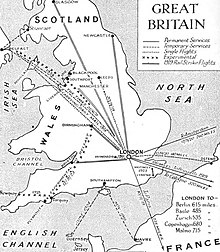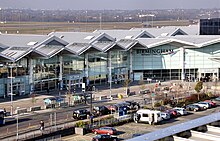
An airline is a company that provides air transport services for traveling passengers or freight. Airlines use aircraft to supply these services and may form partnerships or alliances with other airlines for codeshare agreements, in which they both offer and operate the same flight. Generally, airline companies are recognized with an air operating certificate or license issued by a governmental aviation body. Airlines may be scheduled or charter operators.

Heathrow Airport, called London Airport until 1966, and now known as London Heathrow, is the main international airport serving London, the capital and most populous city of England and the United Kingdom. It is the largest of the six international airports in the London airport system. The airport is owned and operated by Heathrow Airport Holdings. In 2023, Heathrow was the busiest airport in Europe, the fourth-busiest airport in the world by passenger traffic and the second-busiest airport in the world by international passenger traffic. As of 2023, Heathrow is the airport with the most international connections in the world.

Transport in the United Kingdom is facilitated by road, rail, air and water networks. Some aspects of transport are a devolved matter, with each of the countries of the United Kingdom having separate systems under separate governments.

The International Air Transport Association is a trade association of the world's airlines founded in 1945. IATA has been described as a cartel since, in addition to setting technical standards for airlines, IATA also organized tariff conferences that served as a forum for price fixing.

Air travel is a form of travel in vehicles such as airplanes, jet aircraft, helicopters, hot air balloons, blimps, gliders, hang gliders, parachutes, or anything else that can sustain flight. Use of air travel began vastly increasing in the 1930s: the number of Americans flying went from about 6,000 in 1930 to 450,000 by 1934 and to 1.2 million by 1938. It has continued to greatly increase in recent decades, doubling worldwide between the mid-1980s and the year 2000. Modern air travel is much safer than road travel.
AirUK was a wholly privately owned, independent regional airline in the United Kingdom formed in 1980 as a result of a merger involving four rival UK-based regional airlines. British and Commonwealth (B&C)-owned British Island Airways (BIA) and Air Anglia were the two dominant merger partners. The merged entity's corporate headquarters were originally located at Redhill, Surrey, the location of the old BIA head office. It subsequently relocated to Crawley, West Sussex. In addition to the main maintenance base at Norwich Airport, there also used to be a second major maintenance base at Blackpool Airport. This was closed down following Air UK's major retrenchment during Britain's severe recession of the early 1980s. In 1987, Air UK established Air UK Leisure as a charter subsidiary. The following year, Air UK shifted its headquarters to London Stansted Airport. When Stansted's new Norman Foster-designed terminal opened in 1991, the airline became its first and subsequently main tenant.
Bermuda II was a bilateral air transport agreement between the governments of the United Kingdom and the United States signed on 23 July 1977 as a renegotiation of the original 1946 Bermuda air services agreement. A new open skies agreement was signed by the United States and the European Union (EU) on 30 April 2007 and came into effect on 30 March 2008, thus replacing Bermuda II.
A landing slot, takeoff slot, or airport slot is a permission granted by a slot coordinator to use the infrastructure of an airport designated as Level 3 for take-off and/or landing at a specific time and date. Slots should be administered by an independent slot coordinator, often a government aviation regulator such as the U.S. Federal Aviation Administration. In some countries, airport operators are appointed as coordinators even though they are interested parties.

Aircraft engines produce gases, noise, and particulates from fossil fuel combustion, raising environmental concerns over their global effects and their effects on local air quality. Jet airliners contribute to climate change by emitting carbon dioxide, the best understood greenhouse gas, and, with less scientific understanding, nitrogen oxides, contrails and particulates. Their radiative forcing is estimated at 1.3–1.4 that of CO2 alone, excluding induced cirrus cloud with a very low level of scientific understanding. In 2018, global commercial operations generated 2.4% of all CO2 emissions.

In December 1987, following substantial losses, the private, British independent airline British Caledonian (BCal) was taken over by newly privatised British Airways (BA).

The environmental impact of aviation in the United Kingdom are increasing due to the increasing demand for air travel in the country. In the past 25 years the UK air transport industry has seen sustained growth, and the demand for passenger air travel in particular is forecast to increase more than twofold, to 465 million passengers, by 2030. Two airports; London Heathrow and London Gatwick, are amongst the top ten busiest airports in the world for international passenger traffic. Whilst more than half of all passengers travelling by air in the UK currently travel via the five London area airports, regional airports have experienced the most growth in recent years, due to the success of 'no-frills' airlines over the last decade.
Flying Matters was a pro-aviation coalition in the United Kingdom. Members included tourist organisations, airlines, aerospace manufacturers, trade associations, airport operators, growers and others. Formed in June 2007, they have issued briefings, press releases, lobbied Members of Parliament and commissioned advertisements. The organisation was wound up at the end of April 2011 following the withdrawal of four founding members including BA, BAA and Virgin Atlantic.
AirportWatch is an environmental group which campaigns for sustainable air transport through reduction or redistribution of demand, determined by either timing or location.

General aviation (GA) in the United Kingdom encompasses a variety of commercial and non-commercial aviation activities.
Aviation in the United Kingdom refers to the activities surrounding mechanical flight in the United Kingdom, in both civilian and military contexts.
The expansion of Heathrow Airport is a series of proposals to add to the runways at London's busiest airport beyond its two long runways which are intensively used to serve four terminals and a large cargo operation. The plans are those presented by Heathrow Airport Holdings and an independent proposal by Heathrow Hub with the main object of increasing capacity.
Manchester Metropolitan University's Centre for Aviation, Transport and the Environment (CATE) is an international research centre based at the Dalton Research Institute specialising in the environmental impacts of the aviation industry.

Civil aviation in India, the world's third-largest civil aviation market as of 2020, traces its origin back to 1911, when the first commercial civil aviation flight took off from a polo ground in Allahabad carrying mail across the Yamuna river to Naini.

Types of aviation taxation and subsidies, and implementations, are listed below. Taxation is one of several methods to mitigate the environmental impact of aviation.















